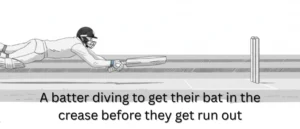Cricket Terms | List & Vocabulary Definitions
Cricket is one of the world’s most popular sports, with its most high-profile matches drawing crowds of over 100,000 spectators and huge TV audiences. If you’re from a country where cricket isn’t widely played but want to understand the game, learning a few basic cricket terms will help you join in conversations about cricket and follow match commentaries.
Here’s a list of 22 cricket terms to get you started.
| The stumps | The three “sticks” behind the player who is trying to hit the ball—there are two sets of stumps on a cricket pitch, one at either end |
| The field | The entire area on which the game is played |
| The pitch | The rectangular area of shorter grass in the middle of the field where the stumps are |
| The boundary | The edge of the field marked by a rope on the ground |
| A run | The word for a point in cricket |
| To run | To try and score runs by running to the other end of the pitch after you’ve hit the ball |
| A bat | The thick piece of wood with a handle that you use to hit the ball |
| Batting | Hitting or blocking the ball with your bat in order to score points (runs) or stop the ball hitting the stumps behind you |
| A batsman, batswoman, batter | The batsmen or batswomen are the two players who are standing in the middle of the field on the team that is currently batting—batter is a widely used alternative gender-neutral term. |
| Out | When a batter is out, it is the end of their “chance” to bat—you can get out by letting the ball hit the stumps behind you or by hitting the ball so a player on the other team can catch it in the air before it touches the ground, for instance |
| Bowling | Throwing the ball in a special way in the direction of the stumps to try and get the batter out (e.g., by hitting the stumps) |
| The bowler | The player who is bowling the ball in the direction of the batter |
| Fielding | Stopping, throwing, and catching the ball when you’re on the team that isn’t currently batting |
| A fielder | One of the players on the field who is not currently batting |
| The wicketkeeper | The player on the fielding team who stands behind the stumps and whose job is to stop or catch the ball if the batter misses it |
| An innings | A team’s “turn” to bat rather than field |
| The wicket | The wicket can refer to:
|
| A wicket | When the fielding team get a batter out (e.g., “India have taken three wickets this morning”) |
| An over | Bowlers bowl in “sets” of six “bowls” (six balls) called an over |
| Leg before wicket (LBW) | A way that the batter can get out by missing or deliberately not hitting the ball but letting it hit their legs |
| A spin bowler | A bowler who specialises in bowling the ball relatively slowly using a technique that makes the ball change direction when it hits the pitch in front of the batter |
| A run out | A way of getting out when you’re running and fail to reach the stumps you are running to before someone on the fielding team hits them with the ball |
Table of contents
Cricket terms
If you’re not familiar with the game of cricket but stumble upon a match on TV or in a park, you’ll probably be a bit confused about exactly what’s going on. Here’s a guide to what you’re seeing, with explanations of the most important pieces of cricket vocabulary that newcomers to the sport need to understand.
Batting and fielding
A cricket match is played between two teams of 11 players each. One team bats while the other fields, and then they swap roles.
When you’re watching, you’ll see two players in the middle of the field holding bats and wearing protective gear—gloves, pads on their legs, and often helmets to protect them from the hard ball. These are the batters (also called batsmen or batswomen), and they’re on the batting team.
All the other players you can see on the field belong to the fielding team.
The cricket pitch
The rectangular strip of very short grass in the middle of the field is called the pitch. At each end of the pitch, there are three wooden sticks called stumps. The batting team begins their innings (their turn to bat) by sending two batters onto the pitch, one at each end.
The player on the fielding team you can see “throwing” the ball (bowling) toward the batter at the other end is called the bowler. A bowler delivers six balls in a row—this set of six balls is called an over. After an over is complete, a new bowler delivers the next over from the opposite end of the pitch.
Runs
To win in cricket, you have to score more runs (points) than the other team. You can only score runs while your team is batting (i.e., during your innings).
The bowlers and the other players on the fielding team (the fielders) are trying to minimize the number of runs that the batters score and get the batters out. When a batter is out, they have to leave the field, and they are replaced by another teammate.
The innings ends when there are no batters left to replace those who are out, when an agreed number of overs has been bowled, or after an agreed time limit.
Getting out
A batter can get out in several ways, including:
- Letting the ball hit the stumps behind them when the ball is bowled at them
- Hitting the ball so one of the fielding team catches it before it touches the ground
Scoring runs
Batters can score runs in a few different ways, including:
- By hitting the ball out of the field (over the boundary): If it touches the ground before going over the boundary, it’s worth 4 runs. If it clears the boundary without touching the ground, it’s worth 6 runs.
- By hitting the ball and running to the opposite end of the pitch: If the batter can run to the other end of the pitch before the fielding team can hit the stumps they are running toward with the ball, they score 1 run. If the batter has more time because it takes the fielding team longer to gather the ball, the batter can run back and forth to score more runs.
If a batter is run out, they have to leave the field, just like they have to do if they are bowled out or caught out.
The crease
A batter has safely completed a run once their bat or any part of their body is inside the area in front of the stumps they are running to. This area is called the crease. If you see a batter diving onto the ground with their bat stretched out in front of them, they are trying to get their bat inside the crease before the fielding team can hit the stumps with the ball.
Changing ends
If the batters take an odd number of runs (like 1 or 3), they will finish at the opposite end of the pitch, so the bowler will be bowling the next ball to a different batter.
When one over is finished, a new bowler bowls the next over from the opposite end, and the batters stay where they are.
The wicketkeeper
The player you can see on the fielding team standing behind the batter (wearing big gloves, pads, and usually a helmet) is called the wicketkeeper. The wicketkeeper’s job is to:
- Stop the ball if the batter misses the ball (so the batters don’t have the opportunity to take a run)
- Get the batter out by catching the ball after it has hit the batter’s bat but before it has touched the ground—e.g., when the batter mistimes their shot and the ball comes off the edge of their bat (they edge or nick the ball)
- Get the batter out by stumping them, which means touching the ball on the stumps or throwing the ball at the stumps when the batter has stepped outside their crease—e.g., when the batter takes a few steps forward before they try to hit the ball and miss it
Frequently asked questions about cricket terms
- Is it inning or innings?
-
In the sport of cricket, it is innings (with an “s”) not “inning.”
In cricket, an innings is a team’s “turn” to bat instead of field.
The plural of the cricket term “innings” is also “innings” (e.g., “In test cricket, the teams get two innings”).
The word “inning” (without an “s”) is a baseball term.
QuillBot’s free AI chat can answer your questions about cricket terms.
- What does sticky wicket mean?
-
A sticky wicket is a British English cricket idiom meaning “a tricky situation” (e.g., “We’re on a bit of a sticky wicket here because we promised two important customers we’d deliver projects next week, and we’re going to have to disappoint one of them”).
It comes from a cricket term meaning a playing surface that is difficult to play on if you are a batter because it is wet and soft.
QuillBot’s free AI chat can answer your questions about sporting idioms.
- What does bowled over mean?
-
If you are bowled over by something, it means that you are very impressed with it, often unexpectedly (e.g., “I was bowled over by the quality of the performances at the talent show”).
This idiom may come from an old cricket term meaning to hit the wooden “sticks” behind the batter.
Use QuillBot’s free AI chat to answer your questions about sporting idioms.
Cite this Quillbot article
We encourage the use of reliable sources in all types of writing. You can copy and paste the citation or click the "Cite this article" button to automatically add it to our free Citation Generator.
Challenger, T. (2025, November 04). Cricket Terms | List & Vocabulary Definitions. Quillbot. Retrieved November 6, 2025, from https://quillbot.com/blog/sports-terms/cricket-terms/



